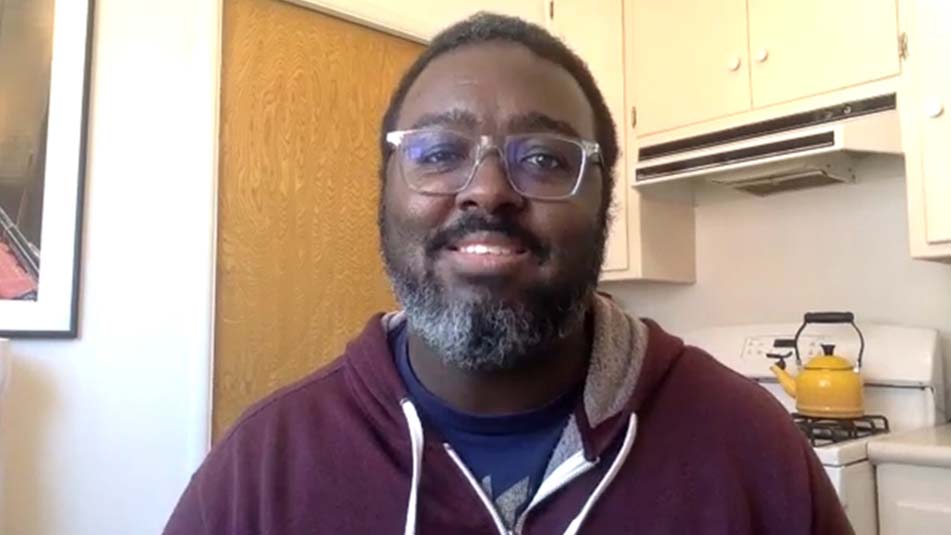Making Jazz Music Education for All

Our teaching artists and staff are moving curriculum online to increase access to arts education for all students, during school closures and into the future. Continuing this work will only be possible with an investment today in our talented and committed staff. Please consider a donation to the SFJAZZ Community Campaign today.
Jamahn Lee
sfjazz school programs coordinator, oakland
Ask Jamahn Lee, SFJAZZ School Programs Coordinator, what he misses most right now and he’ll tell you it’s being around the students and teachers at Westlake Middle School in Oakland. Westlake is a longtime SFJAZZ partner and where the SFJAZZ Education team shares an office space for its East Bay programming.
SFJAZZ hired Jamahn – who has a master’s in Latin American Studies from the University of Texas – from the Oakland Unified School District in 2017, where he was the community school program manager. With a generous grant from the Stupski Foundation, Jamahn and others have since expanded SFJAZZ Education programs to reach every public and charter middle school in San Francisco and Oakland.
Watch Jamahn's story. Music by Tammy Hall.
“When I started three years ago, we were working with two, three, maybe four middle schools in San Francisco. Now, through one program or another, we’re reaching all of the middle schools in SF and Oakland.”
That is a total of 23,000 students a year.
The New Digital Programming Pivot
Now that schools are closed due to COVID-19, Jamahn says SFJAZZ has pivoted to reach students through technology.
But Jamahn and his team also see this time as a growth opportunity.
SFJAZZ Education now has a website with content produced by team instructors. Tutorial videos, curriculum-based concerts, and a webinar by three teaching artists (about improvisation in jazz and hip-hop) are just a few of the new digital offerings. SFJAZZ Education staff is also participating directly with classroom teachers in their regular Zoom class sessions.
This is already opening up the possibility of even greater expansion beyond the Bay Area for SFJAZZ Education. “We want to come out of this with even more to offer beyond Oakland and San Francisco,” says Jamahn.
“We’ve had calls and emails from people across the country wanting to learn if we have anything they can share with their students. This is our opportunity to start developing things we can share with people in, say, Indiana for example, which is where we got the last inquiry from.”
What Students Learn: Jazz, and So Much More
Growing up in Oakland, Jamahn had limited exposure to jazz, just like many middle school students today.
“I didn’t grow up listening to jazz in the home. I came to it through hip-hop, through samples,” he says. “I’d love this groove or those horns – I’d read the liner notes on the albums, and when I found the original piece I’d love it just as much, or more, as the hip-hop song that sampled it.”
Jamahn says that for the thousands of middle school students served by SFJAZZ Education, the programs are a launching point for learning about music, but also history, cultural identity, poetry, and creative expression.
Those three distinct programs are the School Day Concerts – hour-long concerts performed by career jazz artists on the campuses of middle schools and at the SFJAZZ Center; Jazz in the Middle – a language arts program where SFJAZZ teaching artists have two-week to semester-long residencies in the classroom; and Jazz in Session – where jazz musicians are matched with public and charter school music teachers to help instruct and inspire young students.
And, it’s not just the students who love it. “We hire musicians to work with students in music class for an entire year, for free, which is really important because many of the schools in Oakland and San Francisco are underfunded and asked to do a lot with not very much,” says Jamahn. “So anytime they can get something for no-cost or low-cost, it’s a huge help.”
SFJAZZ Education programs offer a key difference compared to other efforts. “There are others, but they are after-school programs that happen off-site. With SFJAZZ, teachers are welcoming us into their classrooms,” he says, “and allowing us to participate and collaborate with them. We integrate ourselves into what the school is doing and what the teachers are doing. That’s the biggest difference.”
He says, “We want to teach about jazz, about life, about U.S. history – especially with students of color – about their history, the contributions that have been made, the struggles of the communities that they came from. As the students get older they’ll come to understand and have an appreciation for that.”
Your Support Is More Important Than Ever
With so much growth over the last three years and with the potential for even greater reach now on our doorstep, Jamahn says financial support for the education program is more important than ever.
“I’m immensely proud of the work we’ve been able to do so far, and we’ve been fortunate enough to have a grant that has allowed us to do it, but we need to find other sources of funding in order to continue to do this work.” Says Jamahn, “The biggest legacy of SFJAZZ will be in the students that we reach.”
Our teaching artists and staff are moving curriculum online to increase access to arts education for all students, during school closures and into the future. Continuing this work will only be possible with an investment today in our talented and committed staff. Please consider a donation to the SFJAZZ Community Campaign today.